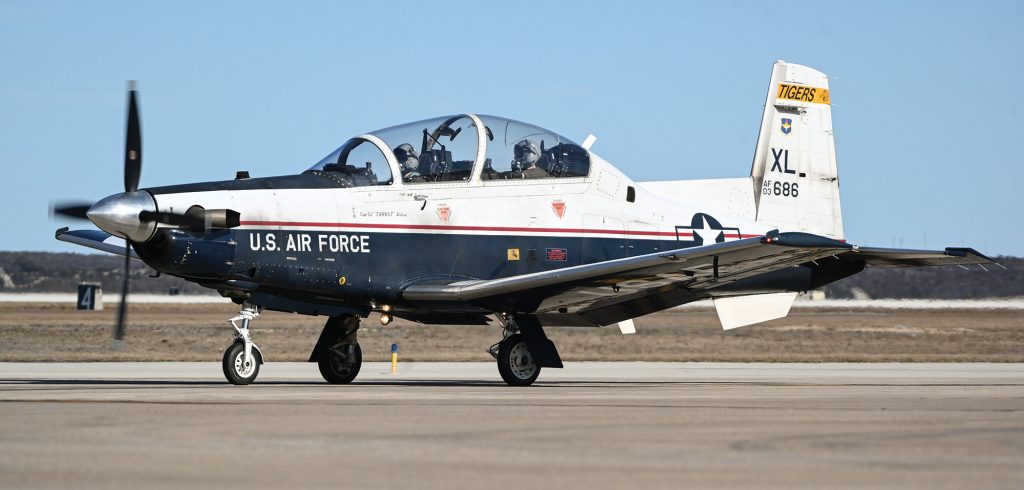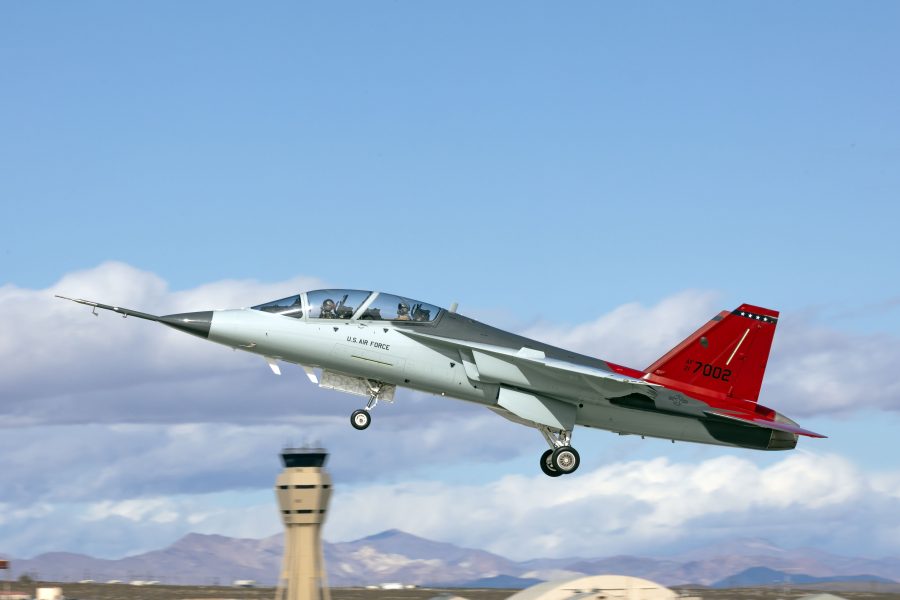NATIONAL HARBOR, Md.—Air Force officials say they’re making progress on getting the T-7A Red Hawk trainer on track after years of delays—and now they’re even exploring whether they can shift some training duties from the T-6 Texan II to the Red Hawk down the road.
“The main thing that we’re focused on with T-7 right now is we’ve got to get that airplane,” Brig. Gen. Matthew A. Leard, director of plans, programs, requirements, and international affairs at Air Education and Training Command, told Air & Space Forces Magazine last month at AFA’s Air, Space & Cyber Conference.
Seven years after awarding the program to a team of Boeing and Saab, Air Force leaders are more eager than ever for it to succeed the aged T-38C, which remains the principal advanced trainer for fighter and bomber pilots.
The T-7 promises to be a major upgrade over the 60-year-old T-38, with modern features in line with today’s fifth-generation aircraft, but the Red Hawk program has been plagued by delays. A revamped approach to fielding the system was introduced earlier this year, with the Air Force buying more test aircraft and delaying production once again.
Now Leard and Rodney Stevens, program executive officer for the training directorate at the Air Force Life Cycle Management Center, say the service and contractor Boeing have also reset both their relationship and expectations moving forward.
“We are ruthlessly executing the program with laser focus, and so with our partners Boeing, we’re making great progress,” Stevens said.
When issues pop up now in testing, Leard said, the Air Force and Boeing keep the program progressing even as they address the problem.
“We’re still going to get to all of the capabilities required of the T-7,” Leard added. “But do you decide to delay the T-7 on something that the aircraft it’s replacing also does not have? That doesn’t make any sense.”
A few key milestones are coming: The first production aircraft will arrive at Joint Base San Antonio-Randolph in December so Air Force pilots and maintainers can start familiarizing themselves with the new trainer ahead of operational test and evaluation, Stevens said.
“It allows us to start training maintenance, start getting reps and sets for the pilots that will be your [operational test and evaluation force],” Leard added. “So you’ve got to build up your number of aircraft. You’ve got to build up your number of trained maintainers. You’ve got to build up your number of pilots to get to the cadre required to enter OT&E.”
In “late fall, early winter,” the Air Force hopes to make a decision on low-rate initial production, Stevens said. More aircraft will start arriving at Randolph in early 2026 and the goal is to have initial operational capability by late 2027.
“We spend a lot of time working with Boeing to get the T-7 delivered,” Leard said. “It is going to be an amazing airplane with a lot of capabilities—in the future. But what we need right now is we need that aircraft so we can stop spending money on T-38 and limping that thing along. And so we’ve got to start getting it in, start divesting of T-38.”
The Air Force plans to buy nearly 350 T-7s through the mid-2030s. At that point, possibilities open up, Leard suggested.
“I think as we get the T-7 and start understanding the capabilities, there are some other options out there that we’re exploring, in terms of its interplay with T-6,” Leard said. What that means he wasn’t quite ready to disclose: “To be determined, is probably the best way to say that.”
The Air Force started buying the turboprop T-6 Texan II to be its primary training aircraft for new student pilots back in 2000, and the average age of the fleet is now creeping toward 20 years—“no spring chicken,” Leard said. Sourcing parts is starting to become a concern.

“In about 10 years, we’re going to have to do some sort of life extension on the T-6,” Leard said, and that timeline lines up well with the T-7’s projected full operational capability. “The thought is, do we … shift that training into a more modern platform like the T-7? We’re still working through all of that kind of stuff to understand what that looks like.”
While such decisions are still years down the road, Leard noted that AETC has already started to explore the idea, agreeing this August to send 10 student pilots to the International Flight Training School in Italy.
The IFTS, which has graduated pilots from more than a dozen NATO and allied countries, flies the T-346A, an advanced jet trainer that has more in common with the T-7 than the T-6.
“I would say that is more about exploring … what are the left and right boundaries of putting a student into a modern jet aircraft right off the bat?” Leard said of the partnership with IFTS.
AETC recently revamped its pilot training pipeline, sending students to commercial, university-based programs for initial training using aircraft like the Cessna 172, Piper Archer, or Diamond Aircraft DA-40 for the initial work, then transitioning the new pilots to military-specific training in the T-6. But Leard suggested leadership is interested in cutting back on T-6 training even more.
“Is there a way to bridge into the T-7 off the bat, and get to those competencies earlier and for everyone?” he asked That “is really what we’re looking at. … It would greatly simplify the pipeline if we were able to do that.”


